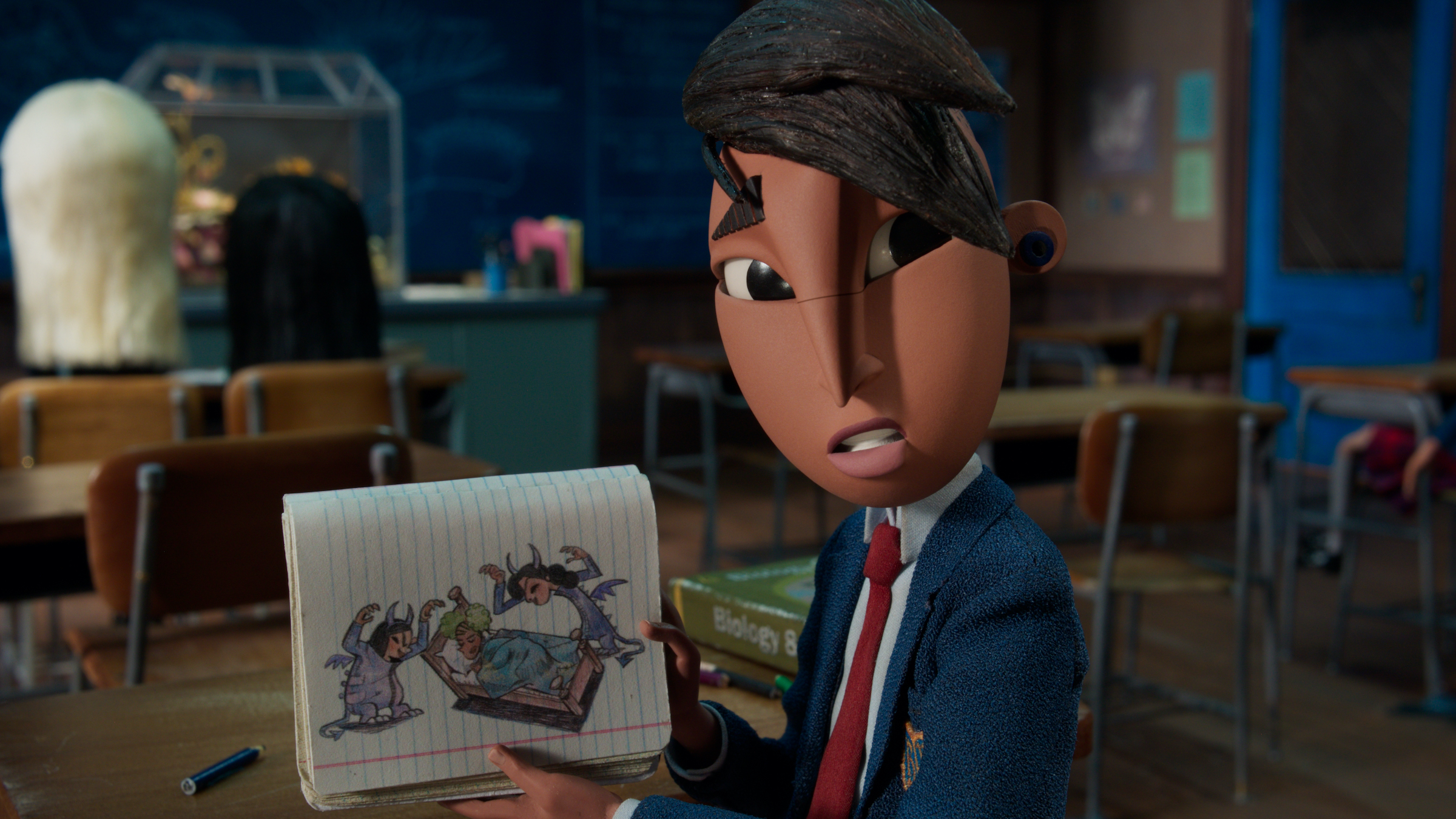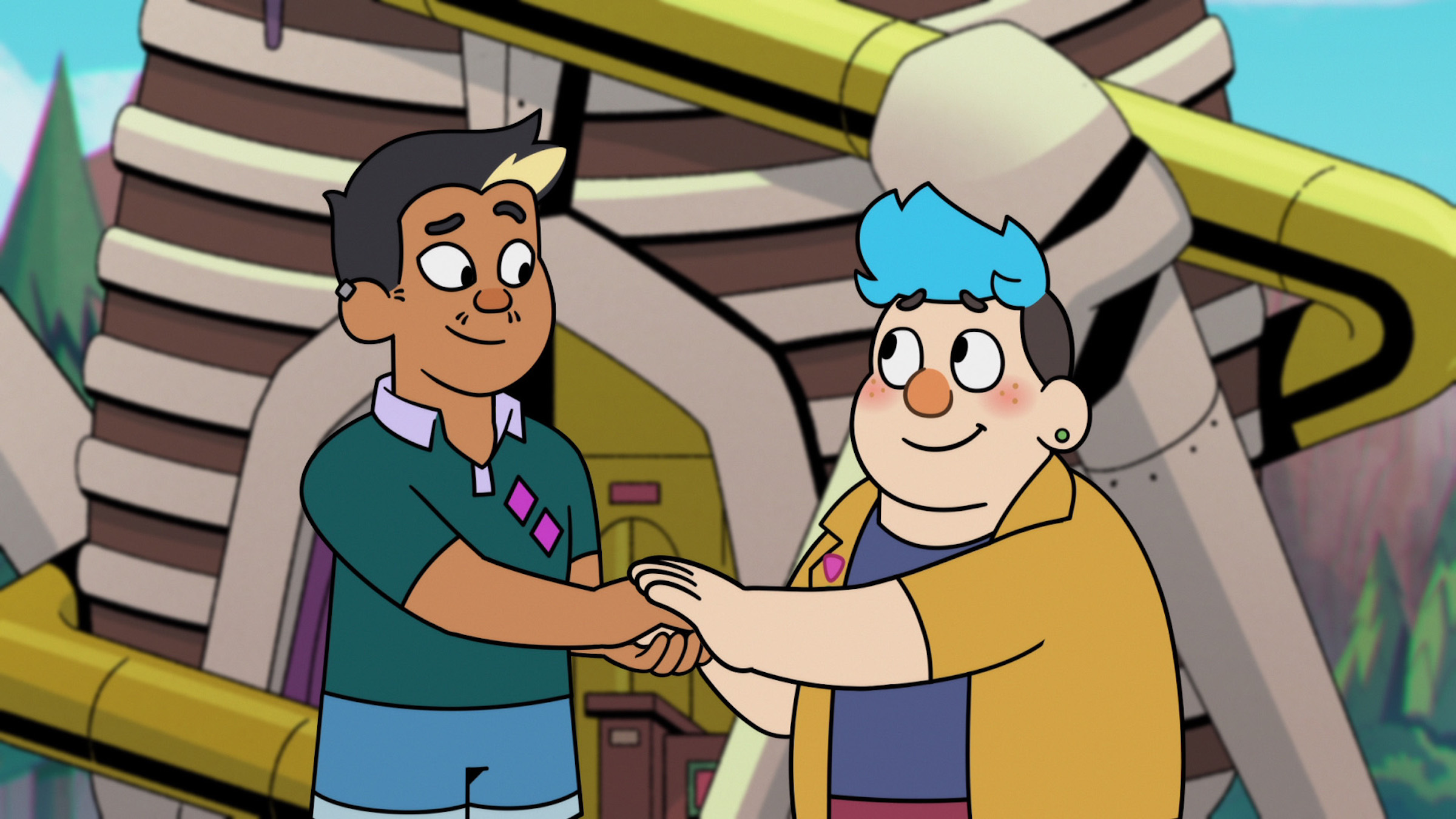
Kat Elliot (Lyric Ross), a new student at the Rust Bank Catholic school for girls, loves punk rock. She wears black lipstick, has eyebrow piercings and green hair. She is decidedly not like Siobhan, Sweetie, and Sloane, a clique of impossibly preppy, posh girls who keep trying to befriend her.
On a walk up a cliffside path, Kat grumbles in frustration. “Why do those poodles keep bothering me?”
Raúl (Sam Zelaya), her new and only friend, replies. “They want you to be like them.” He reaches into his coat pocket and unfolds a photo of four girls posing for the camera: Siobhan, Sweetie, Sloane—and Raúl, before he transitioned.
“Wow,” Kat says. “You were a poodle too.”

The whole exchange—from Wendell & Wild, the new Netflix film from The Nightmare Before Christmas director Henry Selick—lasts just a few seconds before the conversation moves on. It’s a quick, seamless way to reveal that Raúl is transgender. Sarah Ligatich, an assistant editor on the movie, is also trans, and was able to give some notes directly to Selick.
“It was very special, because it wasn’t like, ‘Here, with a big, giant, neon sign: I’m trans and it’s the only thing about me that I am,” says Ligatich. “It was literally just another part of his character and who he is.”
Raúl is trans, yes, but he’s also a loving son, a loyal friend, a talented artist—and ultimately a hero. His character, along with Barney from the Netflix series Dead End: Paranormal Park—another trans character played by a trans actor (Zach Barack)—are prime examples of creators using animation to reclaim horror for queer and trans people, so often vilified by the genre. It’s part of a long history of queer creators reclaiming the genre over several decades.
Read more: The One Spooky Show You Need to Watch This Halloween Season

Wendell & Wild tells the tale of the two titular demons—voiced by Keegan Michael-Key and Jordan Peele, respectively—as they scheme to escape the underworld. Dead End: Paranormal Park, based on a graphic novel series called DeadEndia, takes place in a haunted amusement park, where teenagers and a talking pug work together to fight demons. Both the movie and the TV show exist on a different branch of the horror family tree than slasher flicks and supernatural thrillers—a more comedic one, aimed at younger viewers.
Raúl’s photo reveal may have felt jarring to trans viewers, but great care was taken behind the scenes to get it right. Roughly 30 people—including Ligatich and story and edit coordinator Natalie Carroll, who is nonbinary—met at lunch multiple times to talk it through.
“What we all came to decide was like, ‘Look, this is a character that did this of their own autonomy. No one is dead photo-ing them. They pulled it out of their own pocket,’” says Carroll. “And he went, ‘I’m comfortable with sharing this intimate detail about my life with you and feeling vulnerable and having a lot of power in that.’”
Strides toward more positive representation
“Growing up, I traditionally had seen characters who represented trans experiences vilified,” says Ligatich. “We were Buffalo Bills, we were the killers, we were the monsters. We were shameful and freaks. And I think that inherently engendered—pun intended—a sense of self-shame and self-hatred.”
Nowadays, though, the assistant editor sees film, and especially animation, making massive strides toward more positive portrayals, stripped of shame. Ligatich herself turned to animated shows and graphic novels like She-Ra and Wonder Woman when she was growing up to help her explain who she was.
“Animation—and by extension content and storytelling in general—are really great mediums to visually convey very hard-to-verbalize things,” Ligatich says. “Especially if you’re a younger trans person or nonbinary individual, and you might not have vocabulary to convey that to someone.”
Sam Zelaya, who voices Raúl in his feature debut, felt a connection with the character immediately. They’re both transmasculine and Latino—plus back during the casting process, Zelaya had the same haircut as Raúl. Both are a bit reserved at first, and quietly powerful.
“It’s just really cool to see trans people and trans people of color—especially in a genre piece like this. I think a lot of the time, we are the genre,” says Zelaya. “And everything about the way that our stories are told is centered on one or two facets of your identity, when we’re whole people.”
In the second season of Dead End: Paranormal Park, which debuted earlier this month, we catch a flashback of our blue-haired protagonist, Barney, as a kid. Turns out, Barney was (and still is) obsessed with wrestling. Back then, he went by the moniker B-Rex—a title he reclaims to fight in the Demon Wrestling Federation. Notably, young Barney (pre-transition) is voiced by the same actor who voices teenage Barney (post-transition): Zach Barack.
Read more: A New Documentary Series Illuminates the History and Evolution of Queer Horror

“I really enjoyed doing it because I knew that if it was my voice, the focus wasn’t going to be, ‘Oh, what did Barney sound like?’” says Barack, who also appeared in Spider-Man: Far From Home. “It was more like, ‘What are the other ways he felt like a weirdo?’”
Barney, the everyman of the show, is a weirdo—but so is every other character. Paranormal Park is haunted—full of demons, zombies, ghosts, and teenage crushes—but it’s also a safe haven for Barney. His mom and dad ostensibly “accept” his transition, but they let his grandma misgender him at family dinner. So Barney does what any rebellious teenager would do: runs away from home.
“Something the show got me thinking a lot about was how chosen family isn’t limited to people outside of your biological family,” says Barack. “You have to opt into every relationship you have in your life. And I thought it was really meaningful on a kids’ show to show kids that you can opt in and out of relationships that make you feel safe.”
The immersive power of animation
Barney finds refuge in Paranormal Park alongside a whole host of oddballs: Norma, a high strung fellow teenager, is also a security guard at the amusement park. Pugsley, Barney’s beloved dog, comes with him and becomes possessed by a demon, which allows him to talk. Courtney, a thousand-year-old demon, has been banished from her home and is hanging out in the park in the meantime. Pauline Phoenix, the former owner of the park, is a ghost possessing her own celebrity impersonators. And Logan “Logs” Nguyen is a health and safety officer at the park, who has a mutual crush on Barney. Most of the characters, human or not, are either overtly queer or queer-coded.

“Instead of demonizing queer people—or instead of demonizing the marginalized or the person who is expected—you’re queering the demons,” says Barack.
“You’re making the people who we think are supposed to be bad, queer, or other appealing, and explaining that people are complex and characters are complex and are going to have evil attributes and still deserve love.”
Ash Wu, who is also trans, worked on Dead End as a story artist and story revisionist. He revised sequences like the first kiss (spoiler alert) between Barney and Logs to make them more meaningful—and truer to his own lived experience.

“With Dead End, it’s for a middle-grade audience,” says Wu. “And for so long, trans people have been vilified as predatory—and adult. There was something about using animation to show trans characters, particularly to this level of audience, that I find really important. It feels very de-vilifying.”
In the third episode of the first season, titled “Trust Me,” park employees attend a team-building event hosted by a man named Harmony, who turns out to be a demon who feeds on fear. We peer inside of Barney’s “fear world,” in which a monstrous version of his grandmother, who has not accepted his transition, sits at dinner with his parents, who seem not to notice that anything is wrong.
“There’s something [in] the fluidity of animation to transform an environment, and we go with him into it. It feels really immersive,” says Wu. “And that lets people see what it’s like, really put themselves in his shoes.”
Through all of this, Wu, a horror fanatic, worked to ensure that Barney was still shown as sensitive and attuned to his friends’ needs, despite his confidence and bravado.
“It just is a nice reminder that for every loud, outspoken transphobe, there are so many people who want to portray our stories,” says Wu. “And of course many trans people on board, helping with that.”
More Must-Reads from TIME
- Why Trump’s Message Worked on Latino Men
- What Trump’s Win Could Mean for Housing
- The 100 Must-Read Books of 2024
- Sleep Doctors Share the 1 Tip That’s Changed Their Lives
- Column: Let’s Bring Back Romance
- What It’s Like to Have Long COVID As a Kid
- FX’s Say Nothing Is the Must-Watch Political Thriller of 2024
- Merle Bombardieri Is Helping People Make the Baby Decision
Contact us at letters@time.com